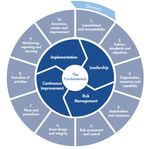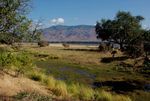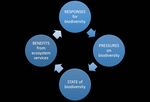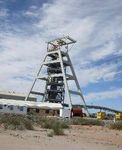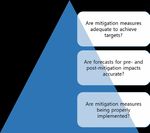Guidelines for Mainstreaming Biodiversity and Ecosystem Services in Extractive Industry - November 2015
←
→
Page content transcription
If your browser does not render page correctly, please read the page content below
Guidelines for Mainstreaming
Biodiversity and Ecosystem Services in
Extractive Industry
November 2015Acknowledgements
The Guidelines for Mainstreaming Biodiversity and Ecosystem Services in Extractive Industry were formulated
through an inclusive consultative process. Many thanks go to representatives of Member States who have been
very supportive to this process and provided valuable guidance on the content from inception. The financial
support provided by the European Union through the 10th European Development Fund (ACP line) to the
development and formulation process is greatly appreciated. Further thanks goes to the Programme Officers
in the SADC Secretariat's Directorate of Food, Agriculture and Natural Resources, who so ably guided the
drafting process. Last but not the least, all could not have been achieved without the technical support of the
International Union for Conservation of Nature (IUCN) and The Biodiversity Consultancy (TBC).
Guideline text compiled by L. A. Bennun, C. Fletcher, C. Savy, M. Starkey
Financial support through
Implemented by:
th
An initiative of the ACP Secretariat funded by the European Union under the 10 EDF
Technical support by
SADC Guidelines for Mainstreaming Biodiversity and Ecosystem Services in Extractive Industry 2Table of contents
1 Summary of key recommendations ....................................................................... 7
1.1 For governments ................................................................................................................................................................................ 7
1.2 For developers ..................................................................................................................................................................................... 8
2 Rationale for this Guidance....................................................................................11
2.1 Background and context ..............................................................................................................................................................11
2.2 Aims ........................................................................................................................................................................................................12
2.3 Scope .....................................................................................................................................................................................................12
2.4 Audience...............................................................................................................................................................................................13
3 Guiding Principles ....................................................................................................14
4 What are biodiversity and ecosystem services? ................................................15
5 The importance of biodiversity and ecosystem services.................................16
5.1 Summary of key points .................................................................................................................................................................16
5.2 BES as a significant issue: the business case .....................................................................................................................16
5.3 Integrating BES into decision-making ...................................................................................................................................19
5.3.1 BES Governance ................................................................................................................................................................19
5.3.2 BES Management Strategy ..........................................................................................................................................19
5.4 Additional resources .......................................................................................................................................................................24
6 Long before development begins - strategic assessment and early
screening ..........................................................................................................................25
6.1 Summary of key points .................................................................................................................................................................25
6.2 Integrating BES with economic and land-use planning ...............................................................................................25
6.3 Thinking big: considering the wider landscape or seascape .....................................................................................27
6.3.1 Ecological context and linkages ................................................................................................................................28
6.3.2 Wider impacts: ...................................................................................................................................................................28
6.3.3 Opportunities: ....................................................................................................................................................................28
6.4 Screening/scoping BES risks and opportunities ...............................................................................................................28
7 When development begins – integrating BES to ensure sustainability .......31
7.1 Summary of key points .................................................................................................................................................................31
7.2 Baseline and targeted BES surveys .........................................................................................................................................31
SADC Guidelines for Mainstreaming Biodiversity and Ecosystem Services in Extractive Industry 37.3 Potential project impacts on BES.............................................................................................................................................32
7.3.1 Categories of project impact ......................................................................................................................................32
7.3.2 BES impact assessment .................................................................................................................................................33
7.3.3 Responses to project impacts ....................................................................................................................................33
7.4 Setting BES objectives ...................................................................................................................................................................33
7.5 Integrating BES with the ESIA process ..................................................................................................................................36
7.6 Additional resources .......................................................................................................................................................................38
8 Planning to mitigate impacts ................................................................................38
8.1 Summary of key points .................................................................................................................................................................38
8.2 The Mitigation Hierarchy across the project lifecycle ...................................................................................................39
8.3 Avoidance ............................................................................................................................................................................................42
8.4 Minimisation .......................................................................................................................................................................................42
8.5 Restoration ..........................................................................................................................................................................................43
8.6 Biodiversity offsets ..........................................................................................................................................................................44
8.7 Additional Conservation Actions ..............................................................................................................................................47
8.8 Additional resources .......................................................................................................................................................................47
9 Putting plans into effect .........................................................................................49
9.1 Summary of key points .................................................................................................................................................................49
9.2 Strengthening regulatory regimes ..........................................................................................................................................49
9.3 Management Strategies and Plans .........................................................................................................................................54
9.4 Monitoring and performance evaluation .............................................................................................................................56
9.5 Additional resources .......................................................................................................................................................................58
10 Glossary ......................................................................................................................60
11 Useful web links .......................................................................................................61
12 References ..................................................................................................................61
SADC Guidelines for Mainstreaming Biodiversity and Ecosystem Services in Extractive Industry 4Table of Figures Figure 1: Summary diagram showing how key BES elements fit in a generic project lifecycle. More detail on these elements is provided in the following guidance. ..................................................................................................................10 Figure 2: Audience for these guidelines ................................................................................................................................................13 Figure 3: Biodiversity (or biological diversity) and ecosystem services are inextricably linked. Ecosystem services depend on the functional and structural integrity of ecosystems, which in turn depend on the species in those ecosystems and their interactions. .........................................................................................................................15 Figure 4: The business case for BES management: issues and opportunities. ...................................................................18 Figure 5: Steps to developing a comprehensive corporate BES Management approach (from UN Global Compact, 2012)....................................................................................................................................................................................................20 Figure 6. Elements to incorporate within a BES Management Strategy (summarised from UN Global Compact6): ..............................................................................................................................................................................................................21 Figure 7: The Operational Management System framework (OGP IPIECA, 2014) ............................................................22 Figure 8. Steps in a good-practice SEA..................................................................................................................................................27 Figure 9: Appropriate responses to different classes of impact ................................................................................................33 Figure 10. Example template for documenting BES management actions (extract from a hypothetical Biodiversity Action Plan)..................................................................................................................................................................................34 Figure 11: The key steps for BES assessment before, during and after an ESIA. From Hardner et al. 201518. ..37 Figure 12: Key characteristics of the Mitigation Hierarchy ...........................................................................................................40 Figure 13: Three broad approaches to Avoidance ...........................................................................................................................42 Figure 14: Three broad kinds of Minimisation ...................................................................................................................................43 Figure 15: Three key considerations for Restoration.......................................................................................................................44 Figure 16: Two types of offset. These can be combined to achieve both outcomes, for example a restoration offset designed to remove invasive species may also protect against future habitat degradation. ........................45 Figure 17: Key interacting elements recommended for an effective BES regulatory regime .....................................51 Figure 18: The four spheres of how ASM impacts the environment (after Kyngdon-McKay et al. 2014). ..........52 Figure 19. Questions answered by BES monitoring .........................................................................................................................57 Figure 20: The State – Benefit – Response – Pressure framework for BES indicators. ...................................................58 SADC Guidelines for Mainstreaming Biodiversity and Ecosystem Services in Extractive Industry 5
Table of Boxes Box A: Performance standards - global benchmarks and drivers for good practice ..............................................17 Box B: Important business and BES initiatives ...............................................................................................................................22 Box C: Managing ecosystem services vs biodiversity: similarities and differences..................................................23 Box D: Transboundary issues ....................................................................................................................................................................27 Box E: Risk Screening, Protected Areas and other sensitive sites ......................................................................................30 Box F: Stakeholder engagement .............................................................................................................................................................35 Box G: Mitigation in aquatic environments......................................................................................................................................41 Box H: Mitigating and managing impacts on ecosystem services .....................................................................................41 Box I: Aggregated offsets ...........................................................................................................................................................................46 Box J: Artisanal and small-scale mining .............................................................................................................................................52 Box K: The importance of partnerships ..............................................................................................................................................54 Box L: Planning for project closure .......................................................................................................................................................55 Box M: Long-term financing for mitigation .....................................................................................................................................56 SADC Guidelines for Mainstreaming Biodiversity and Ecosystem Services in Extractive Industry 6
1 Summary of key recommendations
1.1 For governments
Guidance Project stage Key BES management recommendations: Government
section (see Figure 1)
• Develop and/or strengthen national BES information base
• Develop and/or strengthen a strong information base on
Discovery/reconnaissance
geological/mineralogical resources
Scoping/feasibiility
• Mandate and/or strengthen independent regulatory authority
6 Strategic
• Carry out integrated land-use planning that mainstreams BES
assessment
considerations
and early
• Clarify 'no go' areas and overall BES requirements for extractive
screening
industry
• Regulate for risk screening to inform BES assessment
• Regulate for early application of the mitigation hierarchy
(Avoidance step)
• Set clear criteria for identifying priority BES features, clear
Exploration/prospecting
Pre-design and design
mitigation targets (e.g. 'No Net Loss') and “no project” option
7 BES
• Regulate for transparent process for early and continued
baselines,
stakeholder involvement
potential
• Develop certification mechanisms for experts conducting BES
impacts and
assessments
ESIA
• Develop cadre of well-trained, certified independent domestic
experts/institutes to conduct assessments
• Regulate for rigorous and iterative application of the mitigation
8 Planning to
Design
hierarchy
mitigate
• Develop capacity for thorough review of ESIA within independent
impacts
agency that includes all relevant sectors
• Develop regulatory framework and guidance for BES offsets,
Development/
based on good practice principles and considering long-term
construction
financial arrangements
• Consider and if appropriate develop an aggregated BES offsets
9 Putting
approach nationally
plans into
• Track implementation of mitigation measures by developers
effect
Operations
• Track developer implementation of agreed operations
techniques, mitigation measures and BES outcomes
• Track implementation of BES offsets
SADC Guidelines for Mainstreaming Biodiversity and Ecosystem Services in Extractive Industry 7• Track implementation of mitigation and restoration measures by
developers
Closure
• Track and audit BES outcomes to ensure targets met
• Ensure implementation of long-term arrangements for offset
financing and governance
1.2 For developers
Guidance Project stage Key BES management recommendations: Government
section (see Figure 1)
• Develop corporate policy/commitment on BES based on good
practice
Discovery/reconnaissance
• Develop mechanisms to mainstream BES considerations into
Scoping/feasibiility
6 Strategic corporate and project decision-making processes
assessment • Allocate resources for BES-related actions and closure restoration
and early and mitigation activities in the overall project budget
screening • Undertake early project risk-screening and identify priority BES
features
• Apply Avoidance step of mitigation hierarchy as early as possible
• Engage stakeholders and understand stakeholder concerns
Exploration/prospecting
Pre-design and design
7 BES
baselines, • Engage independent consultants with relevant expertise
potential • Continue transparent stakeholder engagement
impacts and • Carry out targeted but thorough baseline surveys
ESIA
• Apply the mitigation hierarchy iteratively through the ESIA
8 Planning to process
Design
mitigate • Assess feasibility of BES offsets (where needed) for unavoidable
impacts residual impacts
• Develop BES Strategy showing how mitigation targets will be met
• Compile mitigation measures and implementation approach in
BES Action Plan (BAP)
Development/
construction
9 Putting • Integrate costs for the BAP into the overall project budget
plans into • Integrate BES measures into project management systems
effect • Develop and implement detailed BES offsets plans (where
needed), including arrangements for partnerships, governance
and long-term financing
SADC Guidelines for Mainstreaming Biodiversity and Ecosystem Services in Extractive Industry 8Operations
• Monitor implementation of BES measures and outcomes
• Monitor implementation of agreed operations techniques
throughout the project
• Integrate BES measures into closure plans
Closure
• Ensure arrangements in place for continued operation of BES
offsets if needed
SADC Guidelines for Mainstreaming Biodiversity and Ecosystem Services in Extractive Industry 9Figure 1: Summary diagram showing how key BES elements fit in a generic project lifecycle. More detail on these elements is provided in the following guidance. SADC Guidelines for Mainstreaming Biodiversity and Ecosystem Services in Extractive Industry 10
2 Rationale for this Guidance 2.1 Background and context The Southern African region has realised fast economic development over the last decades. One of the major contributors to this development in many countries of the region is the exploitation of mineral and hydrocarbon resources (aggregates of minerals, mineral ores, oil and gas) following the discovery of a number of large deposits/reservoirs. In addition, the region supports extraordinary biodiversity that also plays a key role in the region, contributing to national economies directly, in the form of e.g. nature tourism and employment opportunities and indirectly, in the form of ecosystem services that support most development, including extractive industries. Water in particular is an important ecosystem service relevant to the extractive industries sector. The challenge is that the extractive industry sector may have severe impacts on biodiversity and ecosystem services, at different levels of temporal and spatial scales, which may compromise vital ecosystem services and have far-reaching impacts on other major economic growth sectors such as tourism, especially when these activities take place in or in the vicinity of Protected Areas and other key biodiversity areas. In addition, the impact on ecosystem services even outside of Protected Areas needs careful consideration to ensure sustainable solutions. Globally and regionally, some companies in the extractive industry sector have recognised the value of Protected Areas and biodiversity, and made a commitment to either not exploit minerals inside certain types of protected areas such as natural World Heritage sites, despite potential political and commercial disadvantages (no-go commitments) or take the necessary corrective and remedial measures to safeguard ecosystems. In addition, there is a global move towards more sustainable solutions for exploitation of mineral and hydrocarbon resources, showcased by e.g. the Net Positive Impact Alliance and the ICCM Good Practice Guidance for Mining and Biodiversity at global level. Governments have to carefully weigh the, often shorter-term, income generated by the exploitation of natural resources against the, often longer-term, economic, social and environmental benefits of biodiversity conservation. This requires political balancing and internal coordination of various ministerial departments and services as well as strategic approaches to land use and possible scenario planning at a national scale. Governments need to engage with the extractive industry sector companies to identify opportunities in spatial planning, operational practices and management systems that allow for mineral extraction and environmental responsibility. The extractive industry also has to take a proactive role in ensuring that their operations seriously take into consideration the necessary management measures for the conservation and restoration of biodiversity. However more often both governments and developers lack proper guidance for ensuring sustainable exploitation of such resources. It is against this background that in line with the key action “Develop guidelines on the exploitation of natural resources such as minerals in reserve or protected areas” defined in the SADC Biodiversity Action Plan approved by Ministers responsible for Environment and Natural Resources in November 2013, the SADC Secretariat in collaboration with the Biodiversity and Protected Area Management (BIOPAMA) Programme sought to develop SADC Guidelines for Mainstreaming Biodiversity and Ecosystem Services in Extractive Industry 11
this Guideline for Mainstreaming Biodiversity and Ecosystem Services in Extractive Industry for the SADC
Region. A consultative SADC workshop A,1 in September 2014 developed the framework for these guidelines
and this framework was fleshed out with the help of technical consultants and further engagement with the
SADC Member States.
This guidance covers biodiversity and ecosystem services together. The two concepts are closely interlinked as
ecosystem services flow from biodiversity, when biodiversity is combined and integrated into well-functioning
ecosystems (Section 4). Biodiversity and ecosystem services may sometimes require distinct policy and
management approaches (Box C), but can often be addressed together. Good practice is to consider both in
processes of impact assessment and mitigation.
2.2 Aims
These guidelines aim to:
Help mainstream considerations of biodiversity and ecosystem services (BES) into extractive industry
in the SADC region, where (also see Section 10, Glossary):
o Biodiversity is the variability among living organisms from all sources (terrestrial, marine and
aquatic ecosystems), including diversity within species, between species, and of ecosystems;
o Ecosystem services are the benefits that people, including businesses, derive from
ecosystems. There are four categories: (i) provisioning services, the products people obtain
from ecosystems; (ii) regulating services, the benefits people obtain from the regulation of
ecosystem processes; (iii) cultural services, the nonmaterial benefits people obtain from
ecosystems; and (iv) supporting services, the natural processes that maintain the other
services;
o Extractive industry (EI) is the business of extracting metals, minerals or aggregates from the
earth by mining, quarrying, dredging, and oil and gas operations; and
o SADC 2 is an intergovernmental organization comprising 15 Southern African Member States
whose goal is to promote sustainable and equitable economic growth and socio-economic
development across the region.
Support more sustainable development of extractive industries, by minimizing impacts on biodiversity
and ecosystem services and maximizing social and environmental opportunities;
Bring together the essential information needed to inform BES strategy and decision-making
throughout the project lifecycle;
Provide framework recommendations, aligning with existing regional strategies and signposting more
detailed information sources where relevant.
2.3 Scope
These guidelines apply to:
A
Workshop held by the SADC Secretariat and Member States, with support from the International Union for the Conservation of Nature
(IUCN), the Biodiversity and Protected Areas Management (BIOPAMA) Programme and the IUCN Pan-African Protected Areas and
Conservation Programme.
SADC Guidelines for Mainstreaming Biodiversity and Ecosystem Services in Extractive Industry 12 Non-renewable extractive industries (oil and gas, minerals and metals) on both large and small scales,
including artisanal mining where appropriate;
Both biodiversity and ecosystem services (BES), indicating where the two may require different
approaches;
All habitats (whether inland, coastal or marine), inside and outside protected areas; and
The full project lifespan.
2.4 Audience
These guidelines are aimed at all involved in the guidance, planning, development (including strategic
economic development) and management of extractive industry activities (Figure 2).
Figure 2: Audience for these guidelines
SADC Guidelines for Mainstreaming Biodiversity and Ecosystem Services in Extractive Industry 133 Guiding Principles
There are several key considerations for good practice BES management of EI. These are:
Principle Detail
1 Mainstreaming Mainstreaming biodiversity into decision-making is an essential step in ensuring sustainable
development 3. This guidance thus supports the achievement of Aichi Target 2 and the proposed UN
Sustainable Development Goals 14 and 15. At both Government and business/project level, BES
considerations need to be integrated fully with planning, implementation, monitoring and governance
processes.
2 Natural capital Biodiversity and ecosystem services are living Natural Capital. This guidance aims to secure the best
return from Natural Capital, balancing economic, social and environmental considerations. For the
most important biodiversity features and ecosystem services, good practice is to achieve a net gain,
or at worst no net loss (see Box A). If this is not feasible, the trade-offs between living Natural Capital
and other (e.g. economic) returns should at least be considered explicitly.
3 Ecosystem The ‘ecosystem approach’ developed via the Convention on Biological Diversity is a strategy for the
integrated, adaptive management of land, water and living resources that promotes conservation and
approach sustainable use in an equitable way. A Sourcebook is available to help practitioners implement the
ecosystem approach and to share experiences.
4 Landscape or An implication of the ecosystem approach is that assessment and planning should be considered on
the scale of landscapes or seascapes. This ensures consideration of ecological coherence and
seascape scale connectivity, and that project impacts are considered on a wider geographical basis than the direct
operational footprint (see Box C).
5 Transboundary In the SADC region, there are numerous ecological and social connections across national borders.
Implementation of these guidelines should take a ‘good neighbour’ approach, considering project
context impacts and conservation interventions in a transboundary context where appropriate (see Box D).
6 Full project BES issues need to be integrated with planning and management, monitored and evaluated across
the entire project lifecycle. This means from prefeasibility planning to closure, and beyond closure if
lifecycle remediative measures such as BES offsets need to continue for longer.
7 Precautionary Projects should use the best available BES information. Where there are significant information gaps
or inadequacies a precautionary approach should be taken – rather than assuming, say, that impacts
approach will be insignificant, or restoration efforts successful. Alternatively or additionally, developers should
pro-actively collect the new data needed to inform decision-making.
8 Transparent A key guiding principle is the need to engage and involve stakeholders throughout the lifespan of a
project (see Box F). Stakeholder expectations around BES need to be understood and taken into
stakeholder account as projects develop. Transparency (sharing information and responding to concerns) and
engagement accountability (taking responsibility for project impacts and activities) are important aspects of this.
9 Mitigation Full application of the mitigation hierarchy is at the heart of good practice (see Section 8). Wherever
feasible and cost-effective this should prioritise preventative measures, particularly avoidance but also
hierarchy minimisation, over the remediative measures of restoration and offsets. Application of the mitigation
hierarchy involves understanding BES baselines, assessing BES dependencies and potential impacts,
mitigating and manage BES impacts and identifying BES opportunities, and selecting, measuring and
reporting BES performance indicators.
SADC Guidelines for Mainstreaming Biodiversity and Ecosystem Services in Extractive Industry 144 What are biodiversity and ecosystem services?
Biodiversity and ecosystem services are elements of living Natural Capital (see Glossary). Biodiversity represents
the stock of nature (genes, species and ecosystems). Ecosystem services are the benefits to people that flow
from this stock, when it is combined into integrated and functioning systems. Although biodiversity underpins
ecosystem services, there is not a straightforward relationship between the two. Thus, when managing a system
there may be trade-offs across different kinds of ecosystem services, and between the provision of some
services and the conservation of specific biodiversity features.
Ecosystem services come from the environment but they are defined by their benefits to people. For EI projects,
assessment and mitigation of potential ecosystem service impacts (and compensation if required) involves a
trans-disciplinary approach – combining both social and environmental expertise. Stakeholder consultation is
crucial and not only Affected Communities B but also the project itself may rely on ecosystem services (such as
the provision of clean freshwater). In the widely-applied International Finance Corporation Performance
Standards the trans-disciplinary nature of ecosystem services is demonstrated by the integration of these issues
into standards on community health and safety, cultural values and land acquisition, as well as those on
biodiversity and living natural resources. Figure 3 illustrates the connection between biodiversity and ecosystem
services.
Figure 3: Biodiversity (or biological diversity 4) and ecosystem services are inextricably linked. Ecosystem
services depend on the functional and structural integrity of ecosystems, which in turn depend on the
species in those ecosystems and their interactions.
B
An Affected Community is defined as a group of stakeholders using an ecosystem that is affected by a project and reliant on that
ecosystem service for their wellbeing.
SADC Guidelines for Mainstreaming Biodiversity and Ecosystem Services in Extractive Industry 155 The importance of biodiversity and ecosystem
services
5.1 Summary of key points
Government
• Biodiversity and ecosystem services (BES) form important Natural Capital.
• BES considerations should be mainstreamed into economic and social decision-making, including for
EI.
• There is a need for joined-up, cross-sectoral planning for EI that brings together relevant Ministries
across government.
• Key elements to put in place for improved BES governance are (i) a robust legal and policy framework
for BES, (ii) coherent and integrated development planning, (iii) relevant and accessible BES
information, (iv) an independent and effective BES management authority and (v) strong technical
support from skilled domestic BES consultants.
Developers
• There is a strong business case for good-practice BES management, for reasons related to regulation,
reputation and project dependency.
• Good management of BES-related risk can translate into valuable opportunities. Poor management
can have significant negative consequences.
• BES should be considered a strategic issue in corporate or project risk management frameworks.
• Biodiversity and ecosystem services are interlinked but may require distinct management approaches
at times.
Lenders, local communities, non-governmental organizations
• Good-practice safeguards and standards are helping to drive improvements in BES management by
EI.
• Institutional and individual capacity, and the information base, need strengthening to support
effective BES integration into decision-making for EI.
5.2 BES as a significant issue: the business case
It is increasingly recognized that biodiversity and ecosystem services underpin sustainable development. This
is reflected, for example, in commitments under the Convention on Biological Diversity and in the proposed
Sustainable Development Goals. SADC’s rich biodiversity and the ecosystem services this supports are vitally
important to the regional economy and to human livelihoods and well-being. Avoiding damage to BES in
extractive industry development is an important consideration for Government and for lenders. It is thus
important for Governments to define, at the national/regional level, those BES features which should be
SADC Guidelines for Mainstreaming Biodiversity and Ecosystem Services in Extractive Industry 16considered a priority – and therefore a focus for developer-led Environmental and Social Impact Assessment
(ESIA). There are various means by which such priority can be established – more detail is provided in Box A
Companies are also recognizing that there is a strong business case for effective BES management 5 (Figure 4).
As well as their intrinsic value, BES are important to business because they can impact the bottom line. Good
management of BES-related risk can translate into valuable opportunities. Poor management can have
significant negative implications. The UN Global Compact and IUCN (2012)5 gives more detail on the nature
of drivers for BES-related risk management.
Box A: Performance standards - global benchmarks and drivers for good practice
The BES performance standards of the Multilateral Financial Institutions (e.g. the International Finance
Corporation, World Bank and African Development Bank) provide a useful framework for assessing the
significance of BES-related risks and a benchmark for internationally accepted good practice on BES
management.
The different MFI standards vary in detail but adopt broadly similar approaches. Most now require a
landscape-level approach that considers direct, indirect and cumulative impacts. The high-priority BES
features recognised in many standards include:
• Designated Protected Areas and ‘internationally recognised areas’ (Box E);
• Species or ecosystems at high risk of extinction, globally or nationally;
• Species with very restricted distributions;
• Species that gather in large congregations;
• Ecosystem services of key importance to local communities;
• Ecosystem services valued by global beneficiaries or other stakeholders; and
• Ecosystem services on which the project itself depends.
For the SADC region, important ecosystem services to consider would include the cultural values of sacred
sites, and the tourism supported by particular sites and species.
The International Finance Corporation’s Performance Standards are perhaps the most widely recognised
and applied standard for assessing BES-related risk. Performance Standard 6 6 (PS6) on Biodiversity
Conservation and Sustainable Management of Living Natural Resources has been adopted by many Export
Credit Agencies and by the Equator Principles Financial Institutions, which include 80 of the world’s
biggest banks and cover over 70% of international Project Finance debt in emerging markets. IFC PS6
defines qualitative thresholds for the identification of priority biodiversity, and sets project goals of Net
Gain for ‘Critical Habitat’ C (the most vulnerable and irreplaceable biodiversity features) and No Net Loss
for ‘Natural Habitat’ D (also see Glossary). In terms of ecosystem services, IFC Performance Standard 5 (PS5)
on Land Acquisition and Involuntary Resettlement provides a standard against which issues of project-
related land acquisition and restrictions on land use can be managed with respect to the communities
and persons that use the land.
C
Areas with high biodiversity value, including habitats of significant importance to critically endangered or endangered species, restricted
range or endemic species, globally significant concentrations of migratory and/or congregatory species, highly threatened and/or unique
ecosystems and key evolutionary processes (paragraph 16: IFC, 2012a)
D
Areas composed of viable assemblages of plant and/or animal species of largely native origin and/or where human activity had not
essentially modified an area's primary ecological functions and species composition (paragraph 12: IFC, 2012a)
SADC Guidelines for Mainstreaming Biodiversity and Ecosystem Services in Extractive Industry 17Figure 4: The business case for BES management: issues and opportunities. *‘Social licence to operate’ - see 7 & 8. #Given modern communications and growing awareness, local communities and other stakeholders have a significant ability to slow or stop project progress if transparent good practice is not followed. SADC Guidelines for Mainstreaming Biodiversity and Ecosystem Services in Extractive Industry 18
5.3 Integrating BES into decision-making
5.3.1 BES Governance
For government, mainstreaming BES effectively into decision-making for EI may require strengthening of law
and policy, institutional and individual capacity, and the information base. Five key, interlinked practical
elements need to be in place for improved management of BES in relation to EI:
• Robust legal and policy framework for BES
• Coherent, integrated development planning
• Relevant, accessible BES information
• An independent and effective BES management authority
• Skilled domestic BES consultants.
These points are explained in more detail in Section 9.2).
Important to highlight is the need for joined-up planning and decision-making that brings together relevant
Ministries across government. Plans that consider one sector alone with no wider context, e.g. only for
Protected Areas or for mining concessions, are a recipe for subsequent conflict and confusion (Section 6.2).
Governments need to balance immediate economic opportunities with considerations of long-term ecological
sustainability, and with national and international commitments to biodiversity conservation.
5.3.2 BES Management Strategy
For business, BES should be considered a strategic issue in corporate or project risk management frameworks.
Figure 5 below shows steps to developing a comprehensive BES management approach, and Figure 6 the
elements this might contain. A growing number of corporates are also making public commitments to good-
practice goals for BES management, such as No Net Loss of priority features. 9
SADC Guidelines for Mainstreaming Biodiversity and Ecosystem Services in Extractive Industry 19Figure 5: Steps to developing a comprehensive corporate BES Management approach (from UN Global Compact, 2012) SADC Guidelines for Mainstreaming Biodiversity and Ecosystem Services in Extractive Industry 20
Figure 6. Elements to incorporate within a BES Management Strategy (summarised from UN Global Compact5): SADC Guidelines for Mainstreaming Biodiversity and Ecosystem Services in Extractive Industry 21
The Implementation step of Figure 6 is perhaps the most challenging. The International Association of Oil and Gas Producers (IOGP) and IPIECA (the global oil and gas industry association for environmental and social issues) have produced a framework 10 that identifies four fundamentals for effectively operationalising BES management, with ten organisational elements (see Figure 7), intended to control risk and improve performance. For each of these elements, the framework provides a purpose statement and a set of expectations that define the intended outcome, plus a systematic and auditable ‘Plan-Do-Check-Act’ (PDCA) cycle. Figure 7: The Operational Management System framework (OGP IPIECA, 2014) Box B: Important business and BES initiatives Several important global business initiatives have been formed in recent years to promote good practice in BES management and share experiences and lessons learned. IPIECA (the global oil and gas industry association for environmental and social issues) and the International Council on Mining and Minerals (ICMM) have developed an extensive range of guidance, reports and case studies on BES issues for their members, which are available on their websites. SADC Guidelines for Mainstreaming Biodiversity and Ecosystem Services in Extractive Industry 22
The Cross-Sector Biodiversity Initiative (CSBI) is a partnership between IPIECA, ICMM and the Equator
Principles Association, to develop and share good BES practices in the extractive industries. The initiative
supports innovation and transparent application of the mitigation hierarchy and has two main work
streams: tools and guidance, and knowledge sharing.
The Business and Biodiversity Offsets Programme (BBOP) is a voluntary collaboration of more than 90
companies, financial institutions, government agencies and civil society organisations working together to
test and develop best practice in application of the mitigation hierarchy (see Section 8.2). BBOP has
developed a set of principles and methods based on business experience to help developers demonstrate
no net loss or net gain of biodiversity.
The International Union for the Conservation of Nature (IUCN) has a number of policy positions on the
interface between extractive industries and biodiversity, resulting from different Resolutions and
Recommendations adopted by IUCN Members. The Business and Biodiversity Programme is one example
of IUCN’s positions on extractive industries and supports private sector partners in addressing
environmental and social issues. The Programme connects stakeholders, conducts independent scientific
assessments and develops conservation policy standards and tools. Key resources for the extractives
industry include Integrating Mining and Biodiversity Conservation: Case studies from around the world,
Good Practice Guidance for Mining and Biodiversity, and Partnership for biodiversity: Making biodiversity
part of business.
Box C: Managing ecosystem services vs biodiversity: similarities and differences
Biodiversity and ecosystem services are interlinked but distinct. Biodiversity represents the stock of nature
(genes, species and ecosystems). Ecosystem services are the benefits to people flowing from this stock
when it is combined into integrated and functioning systems.
• Ecosystem services assessment must focus on people as well as environment: it requires stakeholder
consultation and both sociological and ecological expertise. In an ESIA process, the social and
environmental components need to be brought together.
• Impacts on biodiversity and ecosystem services may be spatially different. Affected Communities
(stakeholders reliant on an ecosystem service that is affected by the project) typically live close to the
project site. This isn’t always so – for example, impacts on water supply or quality could affect distant
communities downstream.
• The project itself may depend on specific ecosystem services – so that its viability depends on
maintaining these.
• Offsets for ecosystem services have to deliver to the Affected Communities, so may need to be
separate from offsets for biodiversity.
SADC Guidelines for Mainstreaming Biodiversity and Ecosystem Services in Extractive Industry 23• There may be a gap in time between biodiversity losses from impacts and gains from restoration or
offsets. Time-lags for biodiversity mitigation are not ideal, but may be acceptable to stakeholders.
However, time lags in ecosystem service provision are usually unacceptable to Affected Communities.
• Sometimes lost ecosystem services can only be compensated through an engineering solution (e.g. a
borehole substituting flowing surface water) and/or through money. These approaches are usually not
viable for compensating biodiversity impacts.
• It may not be possible to offset some biodiversity losses or to compensate for some ecosystem
service losses (e.g. spiritual values). Such cases may constitute serious risks to project viability.
• In practice, there can be complex trade-offs between provision of different ecosystem services,
services provided to different stakeholder groups, and biodiversity and ecosystem services. Where this
is so a thorough understanding is needed of trade-offs and dependencies, with extensive stakeholder
consultation and (likely) significant negotiation.
• Affected Communities may rely on ecosystem services that are accessed unlawfully (e.g. illegal timber
cutting or bushmeat harvesting). These may seem outside the project’s responsibility, but associated
risks still need to be managed. Care is needed.
• It may be more complex to assess ecosystem services than biodiversity. Assessment may involve
substantial mapping, measurement and modelling. Though a newer field than biodiversity assessment,
there are many tools available in support: see Section 5.4.
5.4 Additional resources
• Cross-Sector Biodiversity Initiative and CSBI Timeline Tool – joint initiative for developing and
promoting biodiversity good practice in the extractive industries.
• Ecosystem service modelling tools such as InVEST (www.naturalcapitalproject.org/InVEST.html) or
ARIES.
• International Finance Corporation (2012) Performance Standard 6. Biodiversity Conservation and
Sustainable Management of Living Natural Resources.
• IPIECA/OGP: Ecosystem services guidance. Biodiversity and ecosystem services guide and checklists.
OGP Report Number 461.
• IUCN – Holcim: Partnership for biodiversity: Making biodiversity part of business
• South African National Biodiversity Institute (SANBI) – institute leading, coordinating, monitoring
and reporting on state of biodiversity in South Africa
• UN Global Compact and IUCN (2012) A Framework for Corporate Action on Biodiversity and
Ecosystem Services.
• World Resources Institute: Weaving Ecosystem Services into Impact Assessment. A Step-by-Step
Method
SADC Guidelines for Mainstreaming Biodiversity and Ecosystem Services in Extractive Industry 246 Long before development begins - strategic
assessment and early screening
6.1 Summary of key points
Government
• Plans relating to EI need to bring together economic, social and environmental considerations via a
Strategic Environmental Assessment (SEA) process
• An SEA before projects begin planning provides the framework for individual Environmental and
Social Impact Assessments (ESIAs). It can help clarify trade-offs between BES and industry, reduce the
assessment burden on companies and create a better investment climate
• Regulations should encourage BES risk screening at the earliest stage of project planning
• Good practice BES risk-screening and assessment takes into account the wider landscape or seascape.
Developers
• An early-stage screening process is crucial to identify priority BES, take advantage of options to avoid
impacts, and identify gaps for baseline surveys
• Good practice BES risk-screening and assessment takes into account the wider landscape or seascape
• Stakeholders should be engaged as early in the process as possible.
Lenders, local communities, non-governmental organizations
• The BES risk profile early in the project lifecycle allows proper consideration of stakeholder input
before project development progresses.
6.2 Integrating BES with economic and land-use planning
Often there is a potential conflict between conserving what is above the ground or sea-bed and extracting
what is underneath it. Such conflicts are best dealt with by planning in advance, not after they have arisen.
This can be done through a strategic approach to economic and land-use planning that fully integrates BES.
Such an approach can help ensure that both development and conservation targets are met, highlight priorities
for investment, and explicitly consider and resolve trade-offs between competing goals.
Local, regional and national Governments produce many plans relating to land- or sea-use. Examples are
national or provincial Development Plans, Poverty Reduction Strategy Papers, National Adaptation Plans for
climate change and National Biodiversity Strategies and Action Plans (NBSAPs). SADC as a regional body has
produced a Regional Indicative Strategic Development Plan, as well as the Regional Biodiversity Strategy.
Often these plans are narrowly sectoral, setting up potential for conflict where their priorities overlap. A multi-
stakeholder, multi-sectoral approach to planning is more effective, so that plans fully incorporate
environmental, social and economic considerations, consider long-term sustainability, and support and align
fully with other national plans and policies. Availability and exchange between sectors of good information on
SADC Guidelines for Mainstreaming Biodiversity and Ecosystem Services in Extractive Industry 25available resources and opportunities for development from each sector are critical to inform strategic planning and decision-making. Strategic Environmental Assessment (SEA) is a general term for a process and approach that integrates BES with economic and land-use planning. SEA in essence involves systematically identifying the environmental consequences of proposed policies, plans or programmes, so that they are fully included and appropriately addressed, on a par with economic and social considerations. The SEA approach could be applied to any of the plans mentioned above, wherever and whenever it is clear that environmental considerations need to be mainstreamed into planning. SEAs may thus take many different forms. Typically it might be applied to an entire sector (such as a national policy on extractive industry, for example) or to a geographical area (for example, in the context of a regional or local development plan). SEA can also be applied at regional level and for transboundary co-operation (see Box D). SEA provides the context for individual development projects, and can help to streamline and focus the decision-making process and make project-level ESIA a more effective process. Individual ESIAs should fit within the framework of the SEA, as projects that have been anticipated, planned for and (while still needing scrutiny for BES and other impacts) given a degree of pre-approval. Where multiple extractive projects are anticipated to take place, in a region or nationally, conducting a SEA is strongly recommended. This allows cumulative impacts (see also 7.3.1) to be assessed and managed better, options for avoiding sensitive BES to be explored, and possibilities for shared infrastructure to be identified. Such an SEA helps to clarify trade-offs between BES and industry, reduce the assessment burden on companies and create a better investment climate. SEA works by structuring public and government debate, feeding this through a robust assessment of environmental consequences in relation to social and economic aspects, and ensuring that the results inform decision-making and implementation. The SEA process is usually led (or at least endorsed) by government but should bring together stakeholders to debate in a transparent manner, using relevant and high-quality information. Steps in a good-practice SEA are shown in Figure 8. A SEA is no help if it is not used to inform decision-making. A genuinely cross-sectoral SEA that is ‘owned’ by all the relevant branches of government stands the best chance of being implemented. Although SEAs can be carried out ad-hoc as required, many countries now mandate a SEA process by law in particular circumstances. A SEA is also ineffective if it is not supported by the legal regimes for land- and sea-use. It is not uncommon to find conflicting legal provisions relating to (for example) Protected Areas and to prospecting and resource extraction. Any ‘no go’ areas for extraction (e.g. in World Heritage Sites, as recommended by the World Heritage Committee 11) should have a clear legal basis. The rules under which extraction can be considered elsewhere (e.g. No Net Loss of sensitive biodiversity) should also be clearly specified. SADC Guidelines for Mainstreaming Biodiversity and Ecosystem Services in Extractive Industry 26
You can also read
